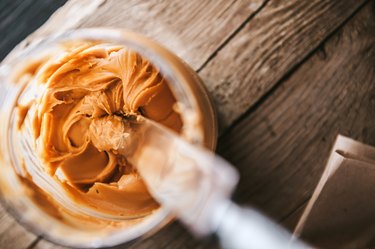
You love peanut butter. It's smooth, creamy and makes everything decadent. You know that it's your best bet to buy a jar without added sugars, oils or additives, which is why you opt for a natural PB. The problem is, when you open the jar for the first time, there's a pool of oil sitting on top, waiting to be stirred in.
Now, here's where your conundrum comes in: Should you actually stir it in? Or could you save some calories by pouring it out?
Video of the Day
Video of the Day
Why You Should Always Stir the Oil Back In
"The oil on the top of the peanut butter is meant to be mixed in," says Amy Kubal, RDN, a registered dietitian in Sioux Falls, South Dakota.
Why? First off, it'll make the PB way easier to spread. If you've ever gotten to the bottom of a jar of natural peanut butter, you know just how tough it is to smear without enough oil mixed in. We're talking rip-your-toast tough. Mixing the oil in is a sure-fire way to save yourself the agony.
Another reason: "The fat in any of the natural nut butters is healthy monounsaturated fat (MUFA)," says Kubal.
Research on more than 90,000 men and women concluded that replacing foods high in saturated fats, refined carbohydrates or trans fats with plant sources of MUFAs (like peanuts and peanut butter) was associated with a reduced risk of heart disease, possibly because this swap leads to healthier blood lipid levels, per a March 2018 study in The American Journal of Clinical Nutrition. Plant-based sources of MUFAs may also contain other good-for-your-ticker nutrients like vitamin E and fiber.
Simply put, pouring the oil out means you'll be missing out on key nutrients.
How Many Calories You’d Save Is Questionable
What's more, if you're tracking your macros or counting calories, the nutrition label on the jar includes the oil mixed in, so it would be tough to know exactly what you're saving if you pour it out. "Ultimately, I'm sure this would shave off some fat and calories, but I don't think it'll be enough to justify eating extra peanut butter," says Kubal.
Peanut butter is calorie-dense, but it has a lot of other things going for it, too. In addition to healthy fats, PB contains about 3 to 4 grams of fiber and about 7 to 8 grams of protein per 2-tablespoon serving.
Other peanut butter "spreads" are already fully mixed, as they may contain stabilizers or added saturated fats (like palm oil), which prevents the separation. To choose the healthiest jar, "I encourage people to look for the ones with the fewest number of ingredients," says Kubal. Find one with no added sugar. "If you're going to cut something out of your peanut butter, make it added sugar, not oil," she says.
Read more: 7 Healthy Peanut Butter Brands
How to Get Your PB to Stir More Easily
Quite frankly, it's annoying to get a jar home and then have to deal with stirring the oil in. The oil splashes out on the top and makes a slick mess on your counter, and still, you can never get it perfectly smooth. We get it.
However, there are a few tricks of the trade:
- Store it upside down: When you get it home, store the jar in the pantry upside down, which
will help some of the oil incorporate. When you're ready to use, flip it back
over and stirring will be an easier affair.
- Know when to refrigerate it: Do not place your PB in the fridge until after you've stirred it. Then, after stirring, keep in the fridge. The cold will help keep the PB intact so that it doesn't separate again.
Above all else, enjoy the PB — it's good for you.
Read more: 8 Peanut Butter Breakfasts FTW
Was this article helpful?
150 Characters Max
0/150
Thank you for sharing!
Thank you for your feedback!